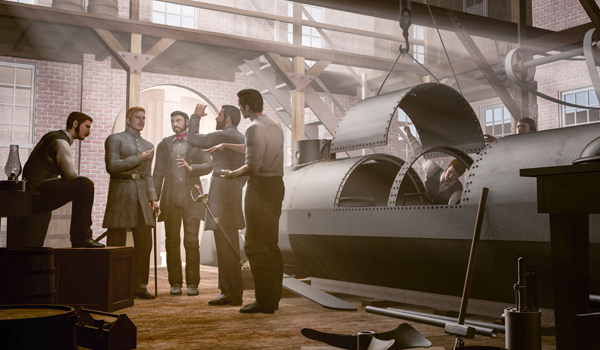A map of the Union's strategy to blockade the Confederacy, the Anaconda Plan [Courtesy of Brett Wadman]

In 1861, the United States was engaged in the Civil War. Near the beginning of the war, the Union had conducted a strategy called the “Anaconda Plan.” One of the Union's main tactics during the war, the Anaconda Plan was to surround the South with a naval blockade. This cut off a significant portion of the Confederacy’s communication, ports, and transportation. The Confederacy suffered because they would no longer be able to get supplies. By late 1861, there were bounties over the largest ships in the blockade, some of them reaching up to $1,000 ($20,000 today). This led to the desperate need for a fracture to occur in the blockade, and for that to happen a barrier had to be broken.
"Confederate Army marine engineer Horace Lawson Hunley, along with fellow shipbuilders James R. McClintock and Baxter Watson, had already constructed the first Confederate submarine, the Pioneer, after hearing that the U.S. Navy was building one as well."
~ Katie Serena
A map of the Union's strategy to blockade the Confederacy, the Anaconda Plan [Courtesy of Brett Wadman]

Southerners were feeling the wrath of the Blockade. Two men named James McClintock and Baxter Watson had an idea that they were hoping could change that. Their idea was to create an underwater three-man boat. Near the beginning of the construction process, a man named Horace L. Hunley was very eager to join the group since he wanted to keep the supply lines open for the Confederacy. Hunley eventually joined, and together the men worked until the Pioneer was built. The ship performed reasonably well but was destroyed by the Confederacy to prevent the ship from being caught by the Union. A second ship was designed, the American Diver (Pioneer II), but it sank in one of its test missions. As hope began to diminish on the concept of a combat submarine, the men tried to create the third submarine. This vessel would blow away expectations, break barriers, and create a gap in the blockade.

What the H. L. Hunley's construction may have looked like
[Courtesy of The Friends of Hunley]
"In 1862 in New Orleans, Louisiana, when Horace L. Hunley eagerly joined James McClintock and Baxter Watson in their venture to build a stealth weapon that traveled underneath the water. Their first attempt was a vessel called the Pioneer, which was ready for testing in February 1862"
~ Robert Bosch